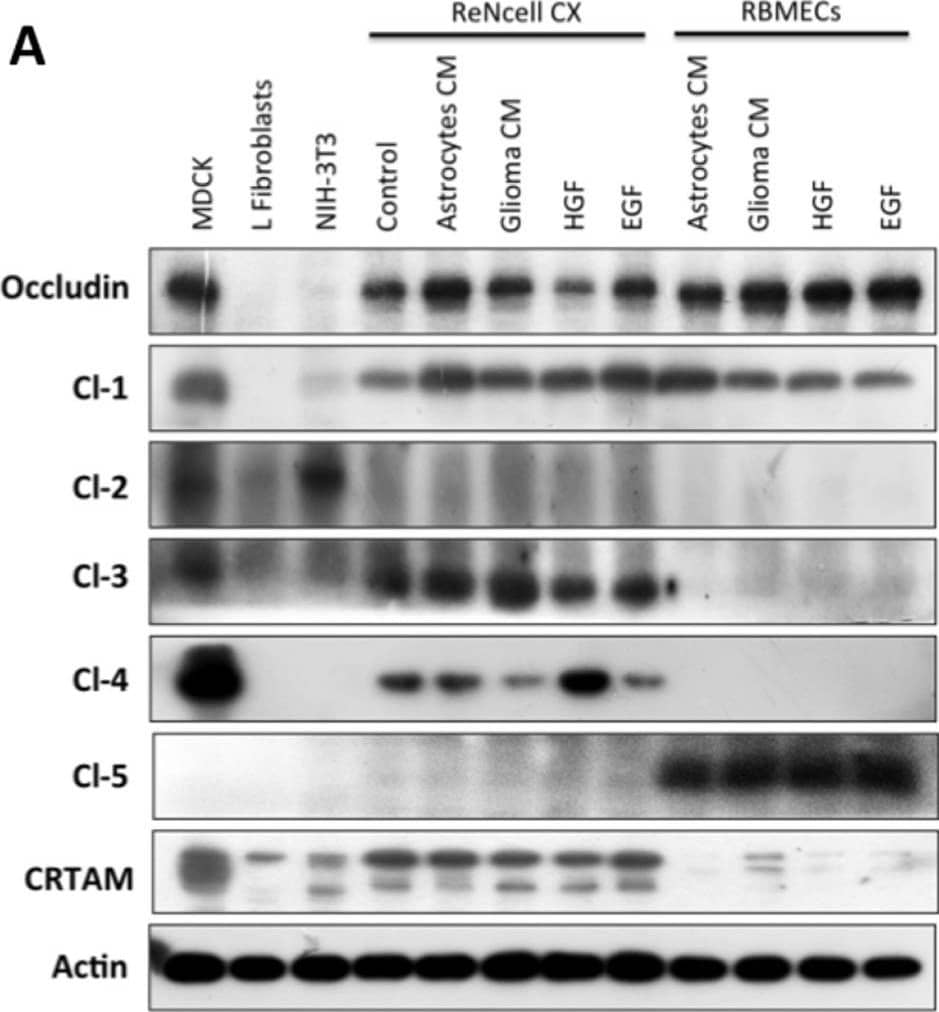Human CRTAM Antibody
R&D Systems, part of Bio-Techne | Catalog # MAB1695

Key Product Details
Species Reactivity
Applications
Label
Antibody Source
Product Specifications
Immunogen
Ser18-Ser286
Accession # O95727
Specificity
Clonality
Host
Isotype
Scientific Data Images for Human CRTAM Antibody
Detection of CRTAM by Western Blot
Expression of TJ proteins in transmigrating cells favors their passage across RBMECs.A) Analysis by Western blots of the expression of occludin, claudins 1 to 5 and CRTAM in NIH-3T3and L-fibroblasts, ReNcells CX and RBMECs. B) The transmigration of NIH-3T3 and L-fibroblasts acrossRBMECs is independent of the CM present in the basal compartment, but is significantly higher inNIH-3T3 fibroblasts that express claudin-2 than in L-fibroblast that do not express TJ proteins.N = 3, F(1,6) = 232.22, ***P<0.001; F(2,8) = 0.0895, ns = not significant; as assessed by two-wayANOVA followed by Bonferroni's post hoc test. C) Exogenous expression of occludin in L-fibroblastsenhances their transmigration across RBMECs monolayers. N = 9, t = 6.411, df = 8; ***P<0.001 asassessed by Student's t-test. D) Competing CRTAM mediated adhesion with soluble human CRTAM(CRTAM-Fc) added to the upper compartment of a Millicell insert, reduces transmigration of ReNcellsCX. N = 4, F(2,6) = 73.86; ***P<0.001, ns = not significant; as assessed by one-way ANOVAfollowed by Bonferroni's post hoc test. Image collected and cropped by CiteAb from the following open publication (https://pubmed.ncbi.nlm.nih.gov/23637756), licensed under a CC-BY license. Not internally tested by R&D Systems.Applications for Human CRTAM Antibody
Western Blot
Sample: Recombinant Human CRTAM Fc Chimera (Catalog # 1695-CR)
Formulation, Preparation, and Storage
Purification
Reconstitution
Formulation
Shipping
Stability & Storage
- 12 months from date of receipt, -20 to -70 °C as supplied.
- 1 month, 2 to 8 °C under sterile conditions after reconstitution.
- 6 months, -20 to -70 °C under sterile conditions after reconstitution.
Background: CRTAM
CRTAM (Class I-restricted T cell-associated molecule) is a nectin family member of the immunoglobulin superfamily that is expressed by activated CD8+ and NK T cells (1‑4). NK activation receptor engagement, but not cytokines, also induce NK CRTAM expression (4, 5). CRTAM is found in spleen, thymus, small intestine, peripheral blood, and surprisingly, in brain where it is highly expressed by Purkinje cells of the cerebellum (1, 2). Human CRTAM is a 393 amino acid (aa), 80 kDa type I transmembrane glycoprotein with a 17 aa signal sequence, a 269 aa extracellular domain (ECD), a 21 aa transmembrane segment, and an 84 aa cytoplasmic domain. The ECD has one V-type and one C1-type Ig-like domain, while the cytoplasmic region shows a potential class I PDZ domain (1‑5). Human CRTAM ECD shows 70%, 43%, and 63% aa identity with mouse, rat, and canine CRTAM ECD, respectively, but 73‑78% aa identity within the Ig-like domains. The V-type Ig-like domain mediates interaction with the corresponding domain on another nectin family member, IGSF4 (also called TSLC-1, Necl-2, Syncam or SgIGSF) (4, 5). CRTAM is a homodimer on the cell surface but does not show homotypic binding in trans (3‑5). The high affinity of CRTAM/IGSF4 adhesion allows CRTAM to disrupt IGSF4 homotypic interactions (3‑5). IGSF4 and T cell receptor co-engagement of CRTAM-expressing CD8+ cells induces increased IFN-gamma or IL-22 production (3, 4). A role in cancer surveillance through NK cell-mediated rejection of IGSF4-expressing tumors has been proposed (3‑5). IGSF4 is expressed broadly, including on epithelia, neurons, a subset of tonsillar B cells (4, 5), and a rare splenic T zone-restricted BCDA3+ dendritic cell population which interacts with CRTAM (3).
References
- Kennedy, J. et al. (2000) J. Leukoc. Biol. 67:725.
- Patino-Lopez, G. et al. (2006) J. Neuroimmunol. 171:145.
- Galibert, L. et al. (2005) J. Biol. Chem. 280:21955.
- Boles, K. S. et al. (2005) Blood 106:779.
- Arase, N. et al. (2005) Int. Immunol. 17:1227.
Long Name
Alternate Names
Gene Symbol
UniProt
Additional CRTAM Products
Product Documents for Human CRTAM Antibody
Product Specific Notices for Human CRTAM Antibody
For research use only
